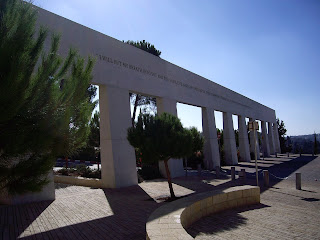 Today (Monday 10 Dec 2007) we moved from Jerusalem to Bethlehem, with important diversions. The first was a visit to Yad Vashem, the Holocaust Martyrs' and Heroes' Remembrance Authority, and its flagship attraction, the Holocaust History Museum.
Today (Monday 10 Dec 2007) we moved from Jerusalem to Bethlehem, with important diversions. The first was a visit to Yad Vashem, the Holocaust Martyrs' and Heroes' Remembrance Authority, and its flagship attraction, the Holocaust History Museum.Most striking to me was the huge concrete bunker, vaguely reminiscent of a Chinese temple, housing the museum's displays. An Israeli Jew who is active in the peace movement guided us through the museum, and I found her commentary both professional and honest. We were not permitted to take pictures inside the museum.
For me, this magnificent historical record imparts two parallel messages. First, Yad Vashem provides a powerful reminder of the horror and extent of totalitarian oppression and the repression of ethnic minorities, and the unfathomable depths to which the human spirit can sink in the pursuit of power.
Having visited the Sydney Jewish Museum twice (I take Baptist theological students there as part of their ethics studies), I would say that it equals Yad Vashem in the quality and focus of its presentation of the Holocaust story. We can learn much about human suffering and loss, about the resilience and nobility of the human spirit in the face of injustice on an unimaginable scale, on the depths to which humans are capable of sinking when they regard other people as less than human, from reflecting on the stories of Jewish victims of Nazi oppression and genocide.
 What Yad Vashem adds to the experience is its symbolic location (in the land of Israel), the pleasure of seeing many Israeli Jews passing slowly and studiously through the museum, and the deeply moving Hall of Names (pictured at right) which aims to identify and collect the names and personal records of all Jews murdered in the Holocaust.
What Yad Vashem adds to the experience is its symbolic location (in the land of Israel), the pleasure of seeing many Israeli Jews passing slowly and studiously through the museum, and the deeply moving Hall of Names (pictured at right) which aims to identify and collect the names and personal records of all Jews murdered in the Holocaust.Many of us have long heard the words "six million" in reference to the full Holocaust death toll. None of us has ever seen six million people, nor can we imagine so many faces together in one place. The risk in remembering the Holocaust death toll as a number is that the individuality of the murdered victims is bypassed. Yet each one was a person with rights and responsibilities just as you and I have. As Benjamin Fondane put it before he was murdered at Auchwitz in 1944: "Remember only that I was innocent and, just like you, mortal on that day, I, too, had had a face marked by rage, by pity and joy, quite simply, a human face!”
Second, having heard many stories from the lips of present-day suffering Palestinians and concerned Israelis, the testimony of Yad Vashem is that the world community, including the Israeli and Palestinian communities, must continue to learn from the most painful 20th-century experience of the Jewish people.
I am not alone in observing that uncomfortable (indeed obscene) similarities have been made between what occurred in Europe in the 1930s and 1940s and what has been contemplated against Palestinian Arabs by elements within the Israeli political and military elite. Many reasonable people will view such associations as either inflammatory or invalid, but I believe we should have the courage to "name the elephant in the room" and commit ourselves to rational dialogue and constructive action aimed at mutual understanding and a just peace. In applying this idiom here, I am not speaking of "truth" but of "perception." It is when we stop talking together in a civil manner that problems begin to grow.
Important differences have been observed too: the most obvious of which are that the Israeli Government is not engaged in a program of genocide but of legitimate self-defence against political and ideological enemies operating outside the rules of war; and that European Jews did not employ suicide bombers to make their political points, as some Palestinians have done and continue to do.
What can be said in response to such observations?
Each of us should employ the gifts of memory, world-knowledge, self-knowledge, critical analysis and wisdom we are given from God, and with the fruits of these gifts begin to shape a world that more fully reflects the values of justice, mercy and peace defined by the Torah and the other Jewish sacred writings.





Pictures:
1. Yad Vashem panorama, courtesy Vad Vashem website.
2. Hall of Names (partial interior), Yad Vashem website.
3. Edifice near entrance to Yad Vashem, quoting Ezekiel 37:14.
4. Exit of Yad Vashem Museum, looking toward the suburbs of Jerusalem.
5. Rev Merrill Kitchen lays a wreath in memory of the millions of European Jews murdered by Nazis.
6. Museum exit precinct.
7. Israeli flags and list of benefactors, Yad Vashem.

No comments:
Post a Comment